In the 21st century, “wicked problems” appear at every turn. Wicked problems, as defined by design theorist Horst W. J. Rittel and city planning professor Melvin M. Webber in the 1970s, are complex social or cultural problems with an unknown number of potential solutions.1 On a global scale, one can see thorny, seemingly intractable issues like poverty, education equality and sustainability as wicked problems.
Wicked problems play out on the global, community and individual levels. Because there are no clear-cut fixes, proposing solutions (and challenging those solutions) often plays a prominent role in politics, and they can affect the missions and operations of businesses worldwide.
A challenge can be considered a wicked problem if includes the following criteria:2
- The problem has an unknown set of potential consequences
- The amount of information available to “solve” the problem is unmeasurable
- The problem is difficult to define and frame
- The problem may be described differently by various stakeholders
- Even after taking action, there is no way of knowing which course of action is best
- It is impossible to gauge whether or not a sufficient solution has been achieved
The William & Mary Online MBA program requires students to identify an example of a wicked problem in their personal or professional lives, and then use that issue to guide them through their studies as they pursue their degree. This unique program enables students to think in terms of the big picture and learn how to execute the details that help make the businesses they work with thrive and, in a broader sense, help make the world a better place.
What Work Is Typically Done on Wicked Problems?
Approaches to alleviating wicked problems are typically individualistic in nature, dependent on factors such as where the problem is occurring and who it is affecting. It is difficult to measure the outcome of work done to solve wicked problems because, by their very nature, they must be confronted in a multitude of different contexts and by different stakeholders.
For example, an improvement of childhood nutrition in Virginia due to a certain strategy may be impossible to replicate when the same strategy is implemented in Kenya. This is because, according to Rittel and Webber, humans “invent” wicked problems through their own activities, so scientific approaches rooted in understanding the natural world are ineffective at analyzing and solving them.3
Wicked problems are often addressed by policymakers, as well as professionals who manage large groups or organizations like educational institutions. Wicked problems can also affect the business world in many ways. A report in the Harvard Business Review stated that although using data and competency modeling to address strategy is wise, increasingly complex working environments are difficult to capture in such a model.2
A business problem might be wicked if it includes:
- Stakeholder disagreements
- Complex roots of the problem
- A lack of precedent for the problem
- Difficulty solving the problem or identifying possible solutions
When wicked problems threaten the strategy and stability of a business organization, top executives as well as various department heads may all have differing opinions about its potential solution, making the problem even more wicked.
How Can You Help Solve a Wicked Problem?
Just because wicked problems are intimidating doesn't mean they're not worth solving. Identifying these problems and committing to a strategy aimed at reaching their best outcomes can help companies and other parties facing wicked problems begin to tackle them. Additionally, the business challenges you face most often may not be to the same scale as an organization-wide wicked problem, but the problem-solving techniques outlined below are applicable across issues faced in general management and throughout various levels of a business.
Some techniques for tackling wicked problems include:
Research and Understand the Wicked Problem From All Angles
Use documented case studies to convey how the wicked problem is affecting the organization. Ask for multiple stakeholders' opinions on the problem, and ask for suggestions on how they would tackle it. In addition to soliciting insight from shareholders and customers, empower employees to present possible solutions.
Use Brand Identity and Values to Come to Possible Solutions
These important components can make working on a wicked problem easier, since you already have guiding principles in place to influence your decisions.
Experiment With Actions
Wicked problems can foster endless hours of analysis. Get better results by trying out strategies and using their outcomes to influence new decisions. Taking some type of thoughtful action is better than being paralyzed by multiple possibilities and doing nothing at all.
Anticipate Wicked Problems Now
Smooth-sailing organizations may not fear the future presence of wicked problems. The best way to stay prepared is to constantly test assumptions that exist about expected revenue and the social impact of your business. This discovery-driven planning can help executives make better decisions throughout the organization and better cope with wicked problems when they arise.
There are many ways individuals can contribute to the solving of wicked problems. Having a clear vision of a successful outcome, promoting a trusting atmosphere for brainstorming, sharing knowledge for better collaboration and testing out ideas to gain small wins for the big picture are all valuable steps in working on wicked problems.4
Tackle Wicked Problems and Build Out Your Problem-Solving Tool Box

To help you effectively strengthen your problem-solving muscles, William & Mary’s Raymond A. Mason School of Business created a user-friendly guide, How to Tackle Big Business Problems: Solving Wicked Problems With Little Bets. Working through business challenges and wicked problems requires creativity and tenacity. In this guide, you will learn more about the discovery process to find solutions for seemingly insurmountable business problems. From idea generation to experimentation to information gathering and idea refinement, we’ll walk you through the best practices for solving complex problems.
In this guide, you will get:
- An introduction to wicked problems—what they are, how to identify them and how they impact business
- A tool to determine just how wicked your business problem might be
- Steps to begin working through your wicked problem
- An introduction to little bets—learning how to test ideas using low-risk experiments
- Considerations to help you discover, test and more fully develop problem-solving ideas
Learn more about this free guide and get your own copy here.
Work on a Wicked Problem as You Study for an Online MBA
Go deeper on the wicked problem and much more with an online MBA. Choosing a wicked problem to work on is an integral part of the Online MBA program at William & Mary. The wicked problem can be something you're facing at work, or a larger business issue you want to tackle. This wicked problem will be thematically tied to your coursework, and through this model, students are able to apply what they're learning to address complex, real-world problems.
- Retrieved on February 14, 2018, from urbanpolicy.net/wp-content/uploads/2012/11/Rittel+Webber_1973_PolicySciences4-2.pdf
- Retrieved on February 14, 2018, from hbr.org/2008/05/strategy-as-a-wicked-problem
- Retrieved on February 14, 2018, from wickedproblems.com/1_wicked_problems.php
- Retrieved on February 14, 2018, from hbr.org/2016/06/wicked-problem-solvers


